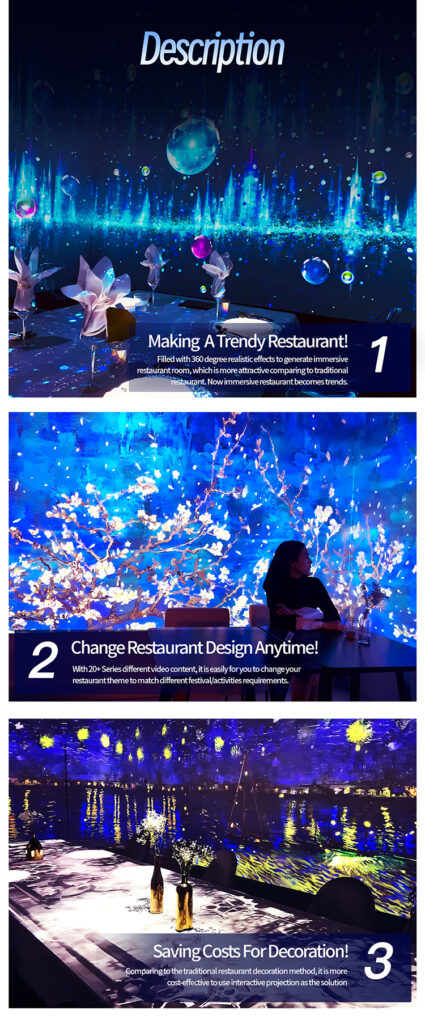In the highly competitive restaurant industry, offering a unique and memorable dining experience is crucial to attracting and retaining customers. One of the most innovative ways to enhance your restaurant’s appeal is by incorporating hologram interactive dining technology.
Understanding Customized Immersive Dining Effects
Customized immersive dining effects involve using technology to create a unique and engaging atmosphere in your restaurant. These effects can transform ordinary dining into an extraordinary experience.
Key Features:
- 3D Projections: Use holograms to project 3D visuals onto tables or around the dining area.
- Interactive Elements: Incorporate touch-sensitive surfaces or motion sensors to allow diners to interact with their environment.
- Ambient Enhancements: Utilize lighting, sound, and scents to create a multi-sensory experience.
Benefits:
- Enhanced Customer Engagement: Interactive and visually stunning effects captivate diners and make their experience memorable.
- Differentiation: Stand out from competitors by offering a unique dining experience.
- Increased Patronage: Attract new customers and encourage repeat visits through word-of-mouth and social media buzz.
Interactive Restaurant Dining Immersive Solutions
Interactive dining solutions leverage technology to create engaging and participatory experiences for guests. These solutions can be tailored to fit the theme and ambiance of your restaurant.
Implementation Strategies:
- Tabletop Projections: Project images and animations directly onto dining tables to create interactive menus and entertainment.
- Augmented Reality (AR): Use AR devices to overlay digital information and visuals onto the physical dining space.
- Interactive Walls and Floors: Transform walls and floors into interactive displays that respond to touch or movement.
Practical Applications:
- Interactive Menus: Allow customers to explore the menu through interactive projections, providing detailed descriptions and visuals of each dish.
- Entertainment: Offer games or storytelling experiences that diners can engage with while they wait for their meals.
- Themed Environments: Create immersive environments that transport diners to different worlds or themes, enhancing the overall dining experience.

Immersive Dining Venue Design Solutions
Designing an immersive dining venue requires careful planning and consideration of both the technology and the physical space. The goal is to create a cohesive and engaging environment that enhances the dining experience.
Design Considerations:
- Layout and Space: Ensure the venue layout accommodates the technology and provides an unobstructed view of projections and interactive elements.
- Lighting and Acoustics: Design lighting and sound systems to complement the visual effects and create an immersive atmosphere.
- Comfort and Accessibility: Provide comfortable seating and ensure that interactive elements are easily accessible to all diners.
Design Tips:
- Thematic Consistency: Maintain a consistent theme throughout the venue to create a cohesive experience.
- Integration of Technology: Seamlessly integrate technology into the design without compromising the aesthetics of the space.
- User Experience: Prioritize the user experience by ensuring that all interactive elements are intuitive and easy to use.
Hologram Restaurant Interactive Projection Software Custom Development
Developing custom software for hologram interactive projections allows you to tailor the dining experience to your specific needs and vision. This software can control various elements of the immersive experience, from visual effects to interactive features.
Key Features:
- Custom Content Creation: Develop bespoke animations and interactive elements that align with your restaurant’s theme.
- Integration with Dining Systems: Ensure the software integrates seamlessly with your restaurant’s existing systems, such as point-of-sale (POS) and reservation systems.
- Real-Time Updates: Allow for real-time updates and changes to the projections and interactive elements.
Development Process:
- Identify Objectives: Define the goals and objectives of the immersive dining experience.
- Choose a Development Team: Partner with experienced developers who specialize in interactive and immersive technologies.
- Testing and Optimization: Test the software extensively to ensure it works smoothly and optimally enhances the dining experience.
Selecting the Best Equipment and Suppliers
Choosing the right equipment and suppliers is crucial to the success of your hologram interactive dining experience. High-quality equipment ensures reliability and superior performance.
Equipment Needs:
- Holographic Projectors: Select projectors that offer high resolution and brightness.
- Interactive Displays: Use touch-sensitive screens and motion sensors for interactive elements.
- Control Systems: Implement robust control systems to manage the various technological components.
Recommended Suppliers:
- Epson: Known for high-quality projectors.
- HYPERVSN: Specializes in holographic display technology.
- Promethean: Offers interactive screens and educational software.
By partnering with reputable suppliers, you can ensure that your immersive dining experience uses the best available technology.
Budgeting and Ordering Your Equipment
Proper budgeting and planning are essential for implementing an immersive dining experience. Consider all costs, including equipment, installation, and ongoing maintenance.
Budgeting Tips:
- Research Prices: Compare prices from different suppliers to find the best deals.
- Plan for Maintenance: Include ongoing costs for maintenance and software updates.
- Look for Bundles: Some suppliers offer packages that include multiple components at a discounted price.
Ordering Process:
- Detailed List: Make a detailed list of all the equipment and materials needed.
- Supplier Negotiation: Negotiate with suppliers for the best price and terms.
- Installation Schedule: Plan the installation to minimize disruption to your restaurant operations.
The cost of creating an immersive dining experience can vary greatly depending on the size and scope of the project. Factors such as the size of the venue, the desired level of interactivity, and the complexity of the custom software development will all play a role in the final price.
There are a number of companies that manufacture and sell holographic projection systems. It is important to consult with a professional to determine the best system for your specific needs.
In addition to holographic projections, other technologies such as virtual reality and augmented reality are also being explored for use in immersive dining experiences. Restaurants are also increasingly focusing on creating experiences that are not only visually stimulating but also stimulate the senses of smell and touch.















